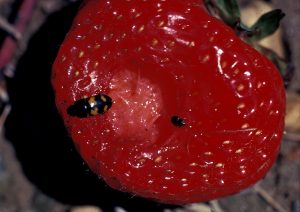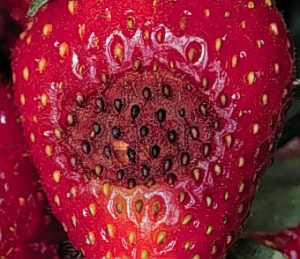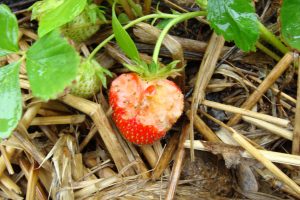Strawberry IPM Newsletter No. 4 — June 7, 2024
EARLY BERRIES NEAR HARVEST IN SOUTHERN MAINE
Insect Pest Counts Lower This Week; Gray Mold Threat Remains with Recent Rains
Situation: Strawberry fruit development has progressed rapidly with warm weather over the past week. A few ripe berries were being harvested in a field in Wells that were grown under rowcovers. Insect and mite activity was lower than last week as a result of timely controls.
Tarnished Plant Bugs: Nymph counts have dropped to below threshold levels in all fields scouted this week as a result of timely insecticide applications. Growers should remain vigilant and scout any fields that have not yet received an insecticide application for the presence of plant bug nymphs. A spray should be applied if 4 or more flower clusters are infested with nymphs out of 30 sampled. The early stages (instars) of the nymphs are very small, only about 1/16”, and light yellow-green in color. Insecticide options for tarnished plant bugs include malathion, Assail®, Brigade®, Bifenture®, Dibrom®, Danitol®, Closer® and PyGanic®.
Strawberry Bud Weevil or “clipper”: All of the locations scouted this week were beyond the bloom-fruit development stage where clipper can cause significant damage. However, later blooming fields, especially in the northern part of the state, should still be scouted for clipper injury until most of the flower buds have opened.
Two-Spotted Spider Mites: Populations were below threshold in all fields scouted this week. Most fields have received an insecticide/miticide application that have significantly reduced mite numbers. We have also seen more predatory mites this week, probably Neoseiulus fallacis, which may be helping to keep two spotted spider mite numbers low. Populations may still increase with warmer, drier weather, so it is important to continue scouting for mites regularly.

Sap Beetles may become a problem as fruit start to ripen. The 1/8 inch long, dark brown beetles chew small holes in ripening fruit, similar to slug injury. The damage often allows rot organisms, such as Botrytis, to then infect the fruit. The best management strategy for sap beetles is good sanitation. Keep the field free of overripe fruit by picking often and thoroughly. Insecticide sprays for this pest can be effective, but should be a last resort during the harvest period. Assail® Brigade®, Dibrom® and PyGanic® are registered for control of sap beetles with pre-harvest intervals ranging from 12 to 24 hours. Read the product label carefully for this and other application instructions and restrictions.
Diseases: Fungicide sprays to protect strawberry fruit against gray mold were recommended for fields in petal fall stage that had not received a fungicide spray in more than a week and/or had experienced more than one inch of rain since the last fungicide application. Fungicide choices for control of gray mold in strawberries include: Topsin M® + captan, Elevate®, Captevate®, Switch®, Scala® and Pristine®. Remember to alternate fungicides with different modes of action for resistance management purposes.
Powdery Mildew: We continue to find early symptoms of powdery mildew on foliage on many fields, including red streaking or blotches on the petioles, fruit stems and calyxes. The symptoms also include upward curling of the leaves, and white, powdery fungus on the undersides of the leaves. When selecting a fungicide for Botrytis fruit rot, use a material that is also effective against powdery mildew such as Captan, Topsin-M®, Pristine®, or Cabrio®, or tank mix the gray mold product with a good powdery mildew product such as Quintec® or Procure®.

Anthracnose Fruit Rot: As fruit starts to size up and ripen in fields that are wet from recent rains, be on the lookout for this fruit rot. Anthracnose is favored by warm, humid conditions and can spread rapidly under rainy, wet conditions, especially if puddles remain in a field after the rain. Anthracnose appears as black sunken lesions with wet, orange (and sometimes gray) spore masses in them. The fungus is able to multiply on leaves without visible symptoms, which is why it may appear suddenly and widespread in a field. Fungicide products for gray mold may not be effective for anthracnose. Products including Cabrio® and Abound® can provide good control of anthracnose fruit rot.
Leaf Spot continues to be found on susceptible varieties this week, but mostly on older foliage. The cool, damp weather has encouraged this problem. Fungicides now being applied for gray mold, including Captan, Luna Sensation®, Mervion® and Pristine® will also provide control of leaf spot.
Birds, especially cedar waxwings, will soon be moving into fields to feed on ripe fruit. Where wax wings are a problem, only keeping a near constant presence in the field and eliminating roosting sites can reduce the damage. Avian Control®, a chemical repellent containing methyl anthranilate is registered for use on strawberries. Some growers have found this to be helpful, others have seen little effect. It is important to use the higher rate on strawberries and begin applications before the birds are regularly feeding in the field.
Bird Damage Prevention for Northern New England Fruit Growers is a free online publication by retired University of New Hampshire Extension Specialist Alan Eaton.

Songbirds, including cedar waxwings are protected by law and should not be killed. However, permits may be issued for killing birds by the U.S. Fish and Wildlife Service if they receive a recommendation for such a permit from the Maine Wildlife Services Office (part of the USDA Animal and Plant Health Inspection Service) in Augusta, along with an application from the grower. There is a $50 fee for the application, and it may take over a month for the permit to be processed. However, the permit is good for one year, so if you have problems this season, you may consider applying for a permit this winter, which would allow you an option to kill birds, if necessary, next season. The Wildlife Damage Office has recommendations for managing birds in crops, and also has some control options available through their office. For more information on permits or bird control contact the office in Augusta at 207.629.5181.
REMINDER: Spring Growers’ Twilight Meeting
The Maine Vegetable & Small Fruit Growers Association will be having a Spring Twilight Meeting on Thursday, June 13, at 5:30 pm at Snell’s Family Farm, 1000 River Road in Buxton. John and Roberta Snell grow a wide variety of vegetables, apples and berries for their stand and CSA, and their daughter Carolyn runs a cut flower business from the farm.
2024-2025 New England Small Fruit Management Guides: A printed version of the new edition of the Guide is now available through our office. The cost of the Guide is $25, including shipping. You can request a copy by sending a check made out to “UMaine Cooperative Extension” to our Highmoor Farm address below. Members of the Maine Vegetable & Small Fruit Growers Association will receive a copy as a benefit of membership. The latest edition of the Guide is also available free online at 2024-2025 New England Small Fruit Management Guides.
You can also get quick access to this information through the UMaine Highmoor Farm news blog or the UMaine Pest Management web page.
Sincerely,
David T. Handley
Vegetable & Small Fruit Specialist
Highmoor Farm
P.O. Box 179
52 U.S. Route 202
Monmouth, ME 04259
207.933.2100
UMaine Extension Diagnostic Research Lab
Pest Management Unit
17 Godfrey Drive
Orono, ME 04473
1.800.287.0279
Where brand names or company names are used, it is for the reader’s information. No endorsement is implied nor is any discrimination intended against other products with similar ingredients. Always consult product labels for rates, application instructions and safety precautions. Users of these products assume all associated risks.
In complying with the letter and spirit of applicable laws and pursuing its own goals of diversity, the University of Maine System does not discriminate on the grounds of race, color, religion, sex, sexual orientation, transgender status, gender, gender identity or expression, ethnicity, national origin, citizenship status, familial status, ancestry, age, disability physical or mental, genetic information, or veterans or military status in employment, education, and all other programs and activities. The University provides reasonable accommodations to qualified individuals with disabilities upon request. The following person has been designated to handle inquiries regarding non-discrimination policies: Director of Equal Opportunity, 5713 Chadbourne Hall, Room 412, University of Maine, Orono, ME 04469-5713, 207.581.1226, TTY 711 (Maine Relay System).
